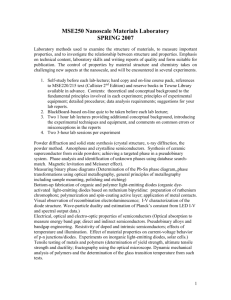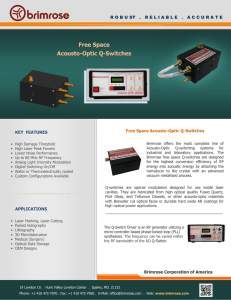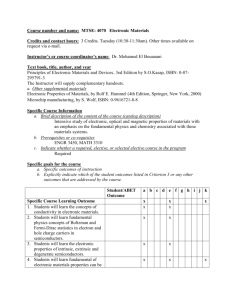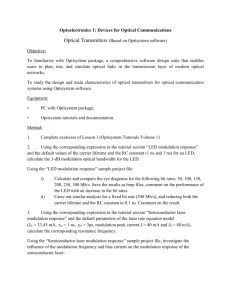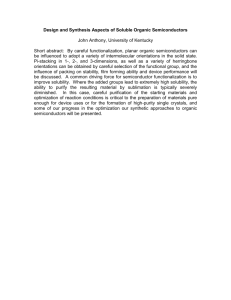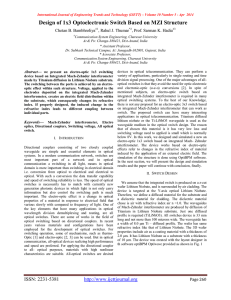Modulators and Semiconductors
advertisement
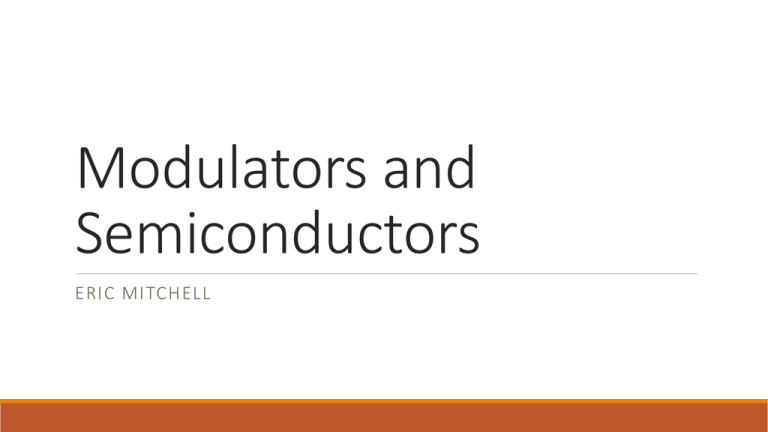
Modulators and Semiconductors ERIC MITCHELL Acousto-Optic Modulators • Based on the diffraction of light though means of sound waves travelling though a median • The quartz crystal has a piezoelectric transducer attached at the end that propagates strong acoustic waves within the crystal. • acoustic waves generated by applying an RF signal to the transducer Common Materials • • • • • • • Lithium Niobate LiNbO3 Tellurium Dioxide TeO2 KTP – Potassium Titanyl Phosphate KTiOPO4 Lead Molybdate Glass Germanium Quartz Acousto-Optic Modulators Scattering: • Ultra sound waves cause Bragg-scattering • scattering efficiencies >90 𝐼𝐷𝑖𝑓𝑓𝑟𝑎𝑐𝑡𝑒𝑑 𝜔𝑙 𝜋𝑙 𝑛6 𝑝2 2 2 = sin ∆𝑛 = sin 𝐼𝐼𝑛𝑐𝑖𝑑𝑒𝑛𝑡 2𝑐 2λ 𝜌𝑣𝑠3 𝐼𝑎𝑐𝑜𝑢𝑠𝑡𝑖𝑐 0.6328 = sin 1.4 𝑙 𝑀𝜔 𝐼𝑎𝑐𝑜𝑢𝑠𝑡𝑖𝑐 λ𝜇𝑚 n: index of refraction Δn: change induced by acoustic wave l: path length in the medium ω: frequency ρ: material density λ: light wavelength vs: speed of sound in the medium p: photoelastic constant of the medium Mω: diffraction figure of merit of the material relative to water 2 𝐼𝐷𝑖𝑓𝑓𝑟𝑎𝑐𝑡𝑒𝑑 𝐼𝐼𝑛𝑐𝑖𝑑𝑒𝑛𝑡 is the fraction of power of the incident beam and diffracted beam Optical Electronics, Yariv Semiconductors Basic Characteristics: • Small energy gap between valence and conduction band (~1.1eV) • Insulating material have a very large energy gap (~5.0 eV) • Semiconductors allow for control of conductivity with impure atoms called dopants • Electrons can easily be excited to conduction band leaving behind holes • Absorption of light increases strongly with frequency Semiconductors Laser diode: •Electrical bias across the laser diode causes electrons and holes to be injected from opposite sides of the p-n junction into depletion region •If electron and holes appear in the same region they may recombine and result in spontaneous emission • The difference between the photon emitting semiconductor laser and the photon emitting (nonlight emitting) semiconductor junction diodes lies in the use of different types of semiconductors • These are the "direct bandgap" semiconductors Examples: • Gallium arsenide • Indium phosphide • Gallium nitride Semiconductors Photodiodes: • Capable of detecting radiation energy hv > Eg • Photodiodes have an intrinsic high resistivity (i) region in which most of the potential drop occurs • Photons are absorbed in the intrinsic high resistivity (i) region • Carriers can then efficiently contribute to the photo current • Thicker depletion region = more efficient collection of carriers =larger quantum efficiency = higher detection bandwidth • Most p-i-n junctions are based on silicon Semiconductors • • • • • • Laser amplification: When excited electrons in the active region return to ground state, amplification occurs R1 and R2 are responsible for the optical feedback in amplifier Advantages: Integrated optical amplifiers are smaller in length than fiber amplifiers Possibility of very large gains ( >20db) in short semiconductor chip ( <400 micrometers) Disadvantage: The presence of residual reflections and the resulting need for optical isolators reflections can give rise to instabilities and noise Electro-Optic Modulation • Combination of properly oriented polarizers and birefringent crystals to control the amount of light transmitted in a optical system The electro-optic effect: • When a voltage is applied across a crystal it induces birefringence • Birefringence crystal: an incident light rays will separate into two rays and scatter in different directions. • Birefringence will be increasing function of applied voltage • Transmission will be a an oscillatory function of applied voltage Consists of rotating retardation plate example: “Quarter wave” (Γ = π/2) Electro-Optic Modulation Transmission factor: 𝐼𝑜 𝛤 = 𝑠𝑖𝑛2 = 𝑠𝑖𝑛2 𝐼𝑖 2 • • • • • 𝜋 𝑉 2 𝑉𝜋 Amplitude modulation: modulator is biased with retardation (Γ ) 50 percent transmission corresponds too applied voltage of V = Vπ/2 or Γ = π/2 small applied sinusoidal voltage modulates transmitted intensity about the bias point maximum transmission known as half-wave voltage Γ is related to V in the equation Vsin(ωt) 𝐼𝑜 𝛤 = 𝑠𝑖𝑛2 = 𝑠𝑖𝑛2 𝐼𝑖 2 𝜋 𝑉 π Γ = sin2 [ + sin(ω𝑡)] 2 𝑉𝜋 4 2 Electro-Optic Modulation Intensity modulation: • can be achieved using crossed polarizers or by means of interference • the interference of modulated and unmodulated light can be achieved with a waveguide interferometer. • i.e. Mach-Zehnder Modulator • high speed telecommunication employ the use of a phase modulator in conjunction with a Mach-Zehnder Interferometer References Yariv, Optical electronics Oshea, Rodes An Introduction to Laser and their Applications Silfvast, T. William Laser Fundamentals Simcick, John ELECTRO-OPTIC AND ACOUSTO-OPTIC DEVICES What When how, Optical Time-Division Multiplexed Communication Networks Part 5
